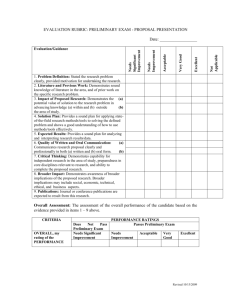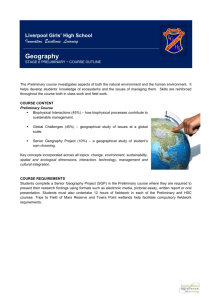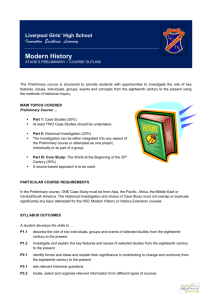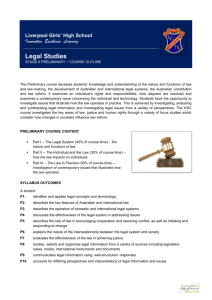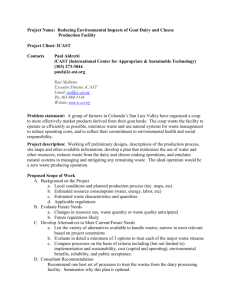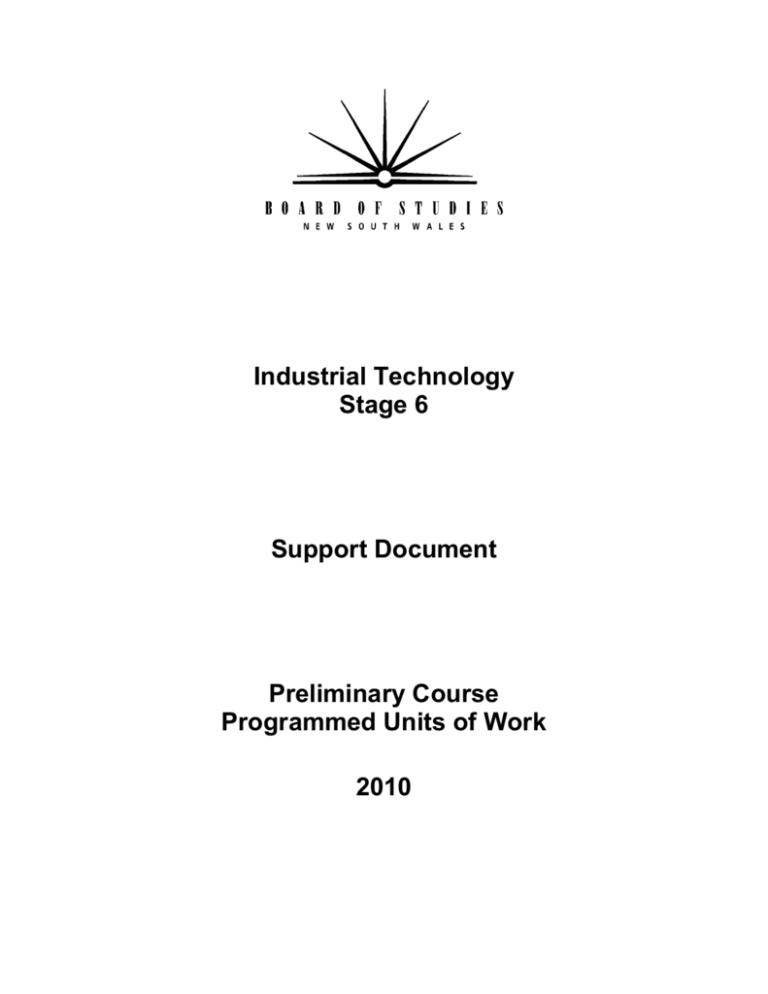
Industrial Technology
Stage 6
Support Document
Preliminary Course
Programmed Units of Work
2010
© 2010 Copyright Board of Studies NSW for and on behalf of the Crown in right of the State of New South Wales.
The Material is protected by Crown copyright.
All rights reserved. No part of the Material may be reproduced in Australia or in any other country by any process,
electronic or otherwise, in any material form or transmitted to any other person or stored electronically in any form
without the prior written permission of the Board of Studies NSW, except as permitted by the Copyright Act 1968.
School students in NSW and teachers in schools in NSW may copy reasonable portions of the Material for the
purposes of bona fide research or study.
When you access the Material you agree:
• to use the Material for information purposes only
• to reproduce a single copy for personal bona fide study use only and not to reproduce any major extract or the
entire Material without the prior permission of the Board of Studies NSW
• to acknowledge that the Material is provided by the Board of Studies NSW
• not to make any charge for providing the Material or any part of the Material to another person or in any way
make commercial use of the Material without the prior written consent of the Board of Studies NSW and
payment of the appropriate copyright fee
• to include this copyright notice in any copy made
• not to modify the Material or any part of the material without the express prior written permission of the Board
of Studies NSW.
The Material may contain third-party copyright materials such as photos, diagrams, quotations, cartoons and
artworks. These materials are protected by Australian and international copyright laws and may not be reproduced or
transmitted in any format without the copyright owner’s specific permission. Unauthorised reproduction,
transmission or commercial use of such copyright materials may result in prosecution.
The Board of Studies has made all reasonable attempts to locate owners of third-party copyright material and invites
anyone from whom permission has not been sought to contact the Copyright Officer, ph (02) 9367 8289, fax (02)
9279 1482.
Published by
Board of Studies NSW
GPO Box 5300
Sydney NSW 2001
Australia
Tel: (02) 9367 8111
Fax: (02) 9367 8484
Internet: www.boardofstudies.nsw.edu.au
September 2010
2010605
Contents
Introduction ............................................................................................................................... 4
Information Specific to Programmed Units of Work ................................................................ 4
Preliminary Course – Sample Assessment Plan and Programmed
Units of Work ....................................................................................................................... 5
Unit 1 Focus Area: Metal and Engineering Technologies ........................................................ 6
Unit 2 Focus Area: Multimedia Technologies ........................................................................ 12
Unit 3 Focus Area: Timber Products and Furniture Technologies ......................................... 16
Industrial Technology Preliminary Course Support Document
Introduction
This support document is designed to assist teachers as they implement the Industrial Technology
Stage 6 Syllabus. It provides advice on programming and assessment for selected syllabus
content from the Preliminary course.
The examples of scope and sequence plans provide ways in which teachers may consider
planning and sequencing units of work, and developing teaching and learning activities.
The sample units of work represent a framework that teachers can customise to build a teaching
and learning program and develop units of work to ensure coverage of the scope of the
Preliminary course. Teachers should provide more specific details about the tasks undertaken,
and the resources used, by students.
Information Specific to Programmed Units of Work
A suggested unit length has been provided; however, teachers may elect to alter this. In some
cases, certain aspects of a unit can be further integrated or combined. Teachers might also find it
appropriate to delete or expand suggested activities, depending on the focus of the unit for a
particular school situation.
4
Industrial Technology Preliminary Course Support Document
Preliminary Course
Sample Assessment Plan and Programmed Units of Work
The Stage 6 course is taught over 240 hours with the Preliminary course a pre-requisite to the HSC course.
The Preliminary course is project-based, with related management folios to support the practical projects. The scope and sequence are based on one design
project and related management folio being completed each term. This can be varied depending on the focus area studied, the number of students and the
design projects chosen. There are many other ways in which similar Preliminary course assessment grids could be constructed that may involve different
types of tasks, timing of tasks and weighting given to each.
Preliminary Course Sample Assessment Plan
Component
Knowledge and understanding of the organisation and
management of, and manufacturing processes and
techniques used by, the focus area
Task 1
Industry Study
Report with Oral
Presentation
Task 2
Project 2 with
Related
Management
Folio
Task 3
Project 3 with
Related
Management
Folio
Task 4
Yearly
Examination
Term 1, Week 6
Term 2, Week 6
Term 3, Week 5
Term 3, Week 7
P1.1, P1.2, P5.1,
P7.1, P7.2
P2.1, P2.2, P3.2,
P3.3, P5.2
P3.1, P4.1, P4.2,
P4.3, P6.2
P1.1, P6.1, P7.1,
P7.2
20
Knowledge, skills and understanding in designing,
managing, problem-solving, communicating and the safe
use of manufacturing processes and techniques through
the production of projects
Marks
20
5
Weighting
5
5
10
40
15
15
30
60
20
20
40
100
Industrial Technology Preliminary Course Support Document
Unit 1 Focus Area: Metal and Engineering Technologies
Sample Scope and Sequence
Syllabus Content
Design
Management and
Communication
Production
Industry Related
Manufacturing
Technology
Project
Term 1
Term 3
Introduction to project work including:
graphical communication techniques
design principles
project management
teamwork
calculating requirements
The relationship of the practical project
to industry. Development of skills in:
literacy and numeracy
use of computer-based technologies
graphics
through folio documentation related to
the project
Focus on:
project quality
consideration of design influences
independent research activities
the use of ICT to enhance the
management folio
Projects
Letterbox
Garden sculpture
Project
Sliding clamp
Project
Torque wrench
Focus on the development of practical
skills that incorporate:
workplace safety
metals and engineering processes
using hand and power tools
introduction to machinery
Focus on:
Focus on:
developing skills
extending and applying the skills
learnt in previous projects
understanding of processes, tools and
machinery
Study of an organisation and
management of an individual business
related to the focus area
Industry Study
Outcomes
Term 2
P1.2, P2.1, P2.2, P3.1, P3.2, P3.3, P4.3,
P5.2
P1.1, P1.2, P3.1, P4.1, P4.2, P5.1, P5.2,
P7.1, P7.2
6
P1.2, P2.1, P3.1, P3.2, P3.3, P4.1, P4.2,
P4.3, P5.1, P5.2, P6.1, P6.2
Industrial Technology Preliminary Course Support Document
Metal and Engineering Technologies
Overview and Rationale
Unit length: 9 weeks
This unit requires students to construct a letterbox. The details are provided in a job sheet. This unit emphasises the development of skills including:
reading and interpreting a detail drawing of the project
constructing the project accurately to drawn details
documenting the management and construction of the project in a management folio.
Students will engage in literacy and numeracy activities to build their understanding and use of the metalanguage of the subject.
Syllabus topics covered
Project Management
Literacy
Numeracy
Communication
Materials
– Properties of ferrous metals
– Applications and uses of metals
– Sections and shapes of ferrous metals
OHS
– Personal Protection Equipment (PPE) and safe working practices
Processes
– Fabrication including marking out, cutting, bending and joining
– Machining including turning, drilling, threading
– Finishing
Tools and Machinery
– Hand tools, lathe, bench drill, cold saw, angle grinder, heat
treatment and welding equipment
Preliminary course outcomes
P1.2 identifies appropriate equipment, production and manufacturing
techniques, including new and developing technologies
P2.1 describes and uses safe working practices and correct workshop equipment
maintenance techniques
P2.2 works effectively in team situations
P3.1 sketches, produces and interprets drawings in the production of projects
P3.2 applies research and problem-solving skills
P3.3 demonstrates appropriate design principles in the production of projects
P4.3 identifies and explains the properties and characteristics of
materials/components through the production of projects
P5.2 uses appropriate documentation techniques related to the management of
projects
Assessment
This unit of work will be assessed through the practical project and accompanying
management folio and may also be assessed through examinations later in the
course.
Quality teaching focus
The focus of this unit of work is to develop skills and knowledge in communication, fabrication and machining. Students engage in activities that build
confidence and understanding of the concepts of management, construction and documentation techniques. This understanding will be gained through a
thorough study of the metalanguage of project management, manufacturing and documentation. The practical project reinforces the learning of these concepts.
7
Industrial Technology Preliminary Course Support Document
Project activities/integrated learning
experiences
Students learn about
Teacher
Introduces students to concepts of reading
and understanding a workshop drawing (job
sheet) using a variety of job sheets and
interpretation questionnaires. There is no
student design component in this project.
Design
object drawing: views of items from
different perspectives:
– orthogonal (2D)
– pictorial (3D) representations
– sketching, rendering using a range of
appropriate media
Students
Analyse the various workshop drawings and
prepare simple detail drawings of related
objects.
Students learn to
industry production drawing
specifications:
– correct dimensions and proportions
– accurate details on drawings and
– exploded views
– CAD and presentation techniques
Materials
properties of ferrous and non-ferrous
metals in common usage:
– strength
– durability
– ductility
– malleability
– lustre
– hardness
Teacher
8
interpret and prepare appropriate
drawings required for the graphical
communication/presentation of
projects
use a range of manual and computerbased graphical techniques to
communicate design details of project
development
identify the properties of a range of
ferrous and non-ferrous metals
Registration
Industrial Technology Preliminary Course Support Document
Project activities/integrated learning
experiences
Students learn about
Students learn to
Demonstrates and discusses selection of
appropriate ferrous and non-ferrous metals
and introduces the use of materials lists.
recognise and use a range of ferrous
and non-ferrous metals
discuss the suitability of a particular
metal for an application
discuss the uses of the various shapes
and forms of ferrous and non-ferrous
metals such as sheet, bar, wire and tube
for particular applications
use various shapes and sections of
metals in practical projects
evaluate a range of manufactured items
to determine appropriate design
features, material suitability and choice
within the focus technology
Students
Define property terminology in relation to
metals and their use.
Examine a range of different types of metals.
Develop a table of comparison including
appearance, properties, possible end uses.
Complete materials lists for a range of
projects.
applications and use of a range of ferrous
and non-ferrous metals:
– copper
– brass
– steel
– silver
– gold
– aluminium
sections and shapes of ferrous and nonferrous metals commonly used:
– tube
– wire
– solid sections
– bar
– sheet
Examine various metal sections and shapes
available for use in different projects.
Examine a range of project samples to
determine the suitability of the material to the
end use.
Report findings back to class in a written or
oral presentation.
Design
factors determining appropriateness of
design:
– economics
– environment
– manufacturing techniques
– sustainability
– decoration
– anthropometrics and ergonomics
material suitability and selection
9
Registration
Industrial Technology Preliminary Course Support Document
Project activities/integrated learning
experiences
Students learn about
Students learn to
Teacher
Demonstrates relevant marking out, cutting,
machining, joining and finishing procedures
using hand and power tools and appropriate
machinery for the completion of practical
project.
Processes
skills and methods used, for a variety of
metals, in:
– marking out
– cutting
– machining
– joining
– finishing
– colouring
– casting
– modifying properties
apply the practical skills and methods
used, for a variety of metals, in
marking out, cutting, machining,
fabricating, joining, modifying
properties, colouring and finishing
engage in a broad range of processes
through a variety of practical projects
using the most suitable process
use the appropriate industry processes,
where possible, in the production of
practical projects
gain an awareness of processes used in
industry, appropriate to the practical
projects being undertaken, which may
not be possible in the school
environment
identify and apply appropriate finishes
to complete projects
identify and apply the various
techniques to modify the properties of
metals in practical projects
applies all aspects of OHS
requirements when working on
projects in the workshop
Explains the procedures undertaken in
industry for colouring and modifying the
properties of metals.
Explains the appropriate occupational health
and safety procedures (OHS), equipment and
responsibilities.
Students
Complete a safety test.
Observe demonstration of processes and use
of tools and equipment. Commence practical
project completing the relevant marking out,
cutting, machining, joining and finishing
procedures using hand and power tools and
machinery to complete the practical project.
Occupational health and safety
workplace safety and communication
– OHS requirements and
considerations
– signage
– personal protection equipment (PPE)
– safe working practices
– risk assessment
10
Registration
Industrial Technology Preliminary Course Support Document
Project activities/integrated learning
experiences
Students learn about
Teacher
Demonstrates the appropriate procedures for
using a range of tools and equipment for use
in practical project number one.
Tools and machinery
the use and maintenance of the tools and
machinery involved in the con-struction
of practical projects such as:
– pliers
– squares
– rules
– dividers
– snips
– punches
– scriber
– files
– shears
– stakes
– hammers and mallets
– heat treatment equipment
– welding/brazing/soldering equipment
– forging and shaping equipment
– clamps
– jigs and vices
– thread cutting equipment
– saws (power and hand)
– pedestal drill
– drill mill
– linisher
– magna bend
– supershears
– buff/grinder
– lathe
– CNC tools and equipment
– portable power tools
Describe tools and machinery used in
industry and their purpose.
Students
Use appropriate tools and equipment safely
and correctly when completing practical
project number one.
Complete an internet search on equipment
used in industry. Describe their use and
purpose including a labelled diagram.
Students learn to
Unit 2 Focus Area: Multimedia Technologies
11
experience a range of tools and
machines appropriate to the metal
being used and the processes being
carried out, to complete practical
projects
safely use tools and machinery
perform basic maintenance procedures
on tools and machinery
identify tools and machinery used by
industry, not available in the school
environment, but appropriate to the
practical activities being undertaken
Registration
Industrial Technology Preliminary Course Support Document
Sample Scope and Sequence
Syllabus Content
Design
Management and
Communication
Production
Industry Related
Manufacturing
Technology
Project
Term 1
Term 2
Introduction to project work including Focus on developing skills in the use of:
multimedia communication techniques multimedia technologies
appropriate software and animation
techniques
Focus on:
project quality
independent research activities
Projects
Multimedia Computer Systems
Text and Graphics in Multimedia
Projects
Web page design
Animated Movie
Project
News Bulletin
Focus on development of practical
skills to incorporate:
workplace safety considerations
multimedia technology processes
and tools
Focus on:
Focus on:
extending skills learnt in previous
projects
skill development in animation
techniques and video editing
broaden understanding of processes and
tools in multimedia
Study
a multimedia technology business
business management practices
industry use of new and emerging
technologies
Industry Study
Outcomes
Term 3
P1.1, P1.2, P2.2, P3.2, P3.3, P5.1,
P5.2, P7.1, P7.2
P1.2, P3.1, P3.2, P3.3, P4.1, P4.2, P4.3,
P5.1, P5.2
12
P1.1, P2.1, P4.3, P6.1, P6.2, P7.1, P7.2
Industrial Technology Preliminary Course Support Document
Multimedia Technologies
Overview and Rationale
Unit length: 8 weeks
This unit requires the students to create a 3-minute animated movie using appropriate software and production techniques. Students may choose any
subject and/or object for their video. The emphasis is on the student researching different software and hardware requirements, as well as storyboarding,
lighting and camera peripherals. Students will then apply this research in the development and staging of their animation. Students will be introduced to a
variety of animation techniques, video-editing, storyboarding, sketching, lighting and filming. Students will complete a Design, Management and
Communication folio documenting their work. They will engage in literacy activities that will build their confidence in the understanding and use of the
metalanguage of the subject.
Syllabus topics covered
Cameras: video and still cameras
– operation
– lighting
– angles/composition
Appropriate software relevant to the project in the
areas of:
– authoring
– publishing
– sound creation/capture /editing
– image creation/capture/editing
– video creation/capture/editing
– text creation/capture/editing
– animation creation/capture /editing
Storyboarding types – linear, nonlinear, hierarchical,
composite
Applications
Preliminary course outcomes
P1.2 identifies appropriate equipment, production and manufacturing techniques, including
new and developing technologies
P3.1 sketches, produces and interprets drawings in the production of projects
P3.2 applies research and problem-solving skills
P3.3 demonstrates appropriate design principles in the production of projects
P4.1 demonstrates a range of practical skills in the production of projects
P4.2 demonstrates competency in using relevant equipment, machinery and processes
P4.3 identifies and explains the properties and characteristics of materials/components
through the production of projects
P5.1 uses communication and information processing skills
P5.2 uses appropriate documentation techniques related to the management of projects
Assessment
This unit of work will be assessed through the practical project and accompanying management
folio and may also be assessed through examinations later in the course.
Quality teaching focus
The focus of this unit of work is to provide the necessary skills and knowledge to create simple animations. Students engage in activities that build
confidence and understanding of the concepts of animation and various presentation techniques. This engagement will be gained from a thorough study of
the metalanguage and the relevant related practical concepts of animation and video editing. Practical projects reinforce the learning of these concepts.
13
Industrial Technology Preliminary Course Support Document
Project activities/integrated learning
experiences
Students learn about
Students learn to
Teacher
Provides students with project details.
Demonstrates stop motion software including:
capture
frame rates
digital video (PAL, NTSC etc)
camera inputs from digital still or video
cameras (pan, zoom etc)
backgrounds
props
‘blue screen’ effects
lighting effects.
Operating a computer system
select and operate computing packages –
manipulate data between applications
input devices, including:
– keyboard
– mouse
– scanners
output devices:
– screens
– printers (ink-jet and laser)
– projectors
cameras:
– digital/analogue
– still/video
appropriate software relevant to the
project in the areas of:
– authoring
– publishing
– sound creation/capture/editing
– image creation/capture/editing
– video creation/capture/editing
– text creation/capture/editing
– animation creation/capture/editing
manipulate and integrate data
between a range of software
applications
Demonstrates the use of appropriate software
to create animation figures, including:
imitating movement
movement/frame rate considerations
figures such as Stikfas.
Describes a range of storyboarding techniques.
Demonstrates suitable video-editing software,
import/export (cross-platform file types),
transitions, special effects, titles, credits and
adding sound.
Students
Storyboard the animations. Construct suitable
sets/backgrounds, as necessary, and set up
software and cameras to film their animation.
Design sets for animation including
Multimedia design
storyboarding types including:
– linear
– nonlinear
– hierarchical
– composite applications
14
identify and use input and output
devices in conjunction with specific
multimedia software
set up and operate basic still and
video cameras for use in small
media productions
investigate and use of range of
software suitable for the creation,
editing and publishing of
multimedia projects
identify and use planning processes
related to a range of multimedia
presentations
investigate and discuss the processes
of obtaining, creating and modifying
images, sound and text
Registration
Industrial Technology Preliminary Course Support Document
Project activities/integrated learning
experiences
Students learn about
Students learn to
background, props and lighting.
Import digital video into suitable editing
software packages, apply transitions, titles,
credits, sound/music and export to a suitable
cross-platform file type (QuickTime) for
viewing.
produce and manipulate digital
images
use presentation techniques and
strategies in multimedia
author a multimedia product
apply principles of design in the
planning and production of
multimedia presentations
Capture enough frames for a 2-minute
animation.
sound creation/editing/conversion
– wave
– MIDI
– podcasts
– compression formats/codecs
video and still cameras
– operation
– lighting
– angles/composition
Complete the editing of their animation.
data integration
Burn to CD/DVD for viewing.
Complete accompanying management folio.
15
Registration
Industrial Technology Preliminary Course Support Document
Unit 3 Focus Area: Timber Products and Furniture Technologies
Sample Scope and Sequence
Syllabus Content
Design
Management and
Communication
Production
Industry-related
Manufacturing
Technology
Project
Term 1
Term 2
Term 3
Introduction to project work and the
relationship to industry, including:
graphical communication techniques
occupational health and safety
planning processes
literacy and numeracy
Development of skills in:
use of computer-based technologies
(including CAD) to enhance the
management folio
teamwork
Focus upon:
project quality
consideration of design influences
independent research activities
Project
Entertainment unit
Project
Station clock
Project
Folding stool
Development of practical skills
incorporating:
workplace occupational health and
safety considerations
timber product processes, tools and
machinery
Build upon skills learnt in the
introductory project. Focus on
developing:
understanding of processes, tools and
machinery
teamwork skills in a group-based
project
Focus on:
extending skills learnt in the previous
projects
P1.1, P1.2, P2.2, P3.1, P3.3, P4.1, P4.2,
P6.1
P1.1, P2.1, P4.3, P6.2, P7.1, P7.2
Industry Study
Study of timber products and furniture
technologies business, eg South Coast
Kitchens and their management practices
Outcomes
P1.1, P1.2, P2.1, P3.2, P4.2, P5.1, P5.2,
P7.1, P7.2
16
Industrial Technology Preliminary Course Support Document
Timber Products and Furniture Technologies
Overview
Unit length: 8 weeks
This unit requires the students to design and construct an entertainment unit that will house a micro hi-fi system, eg radio/CD bookshelf or similar iPod, MP3
sound system. The emphasis is on the student researching and designing for different size requirements of specific systems, as well as the use of suitable
construction methods allowing for the different materials that will be incorporated in its design. Students will apply this research in the development and
construction of their final product. Students will be introduced to a variety of design, materials, hardware and construction techniques. They will engage in
literacy activities that will build their understanding and use of the metalanguage of the subject.
Syllabus topics covered
Design – elements and principles
Communication
Graphical skills
ICT
Project management
Literacy
Numeracy
Materials
– timber and timber products
– properties and characteristics of hardwoods
and softwoods
– manufactured boards
Processes, tools and machinery
Preliminary course outcomes
P1.1 describes the organisation and management of an individual business within the focus area
industry
P1.2 identifies appropriate equipment, production and manufacturing techniques, including new and
developing technologies
P2.1 describes and uses safe working practices and correct workshop equipment maintenance
techniques
P3.2 applies research and problem-solving skills
P4.2 demonstrates competency in using relevant equipment, machinery and processes
P5.1 uses communication and information processing skills
P5.2 uses appropriate documentation techniques related to the management of projects
P7.1 identifies the impact of one related industry on the social and physical environment
P7.2 identifies the impact of existing, new and emerging technologies of one related industry on
society and the environment
Assessment
This unit of work will be assessed through the practical project and accompanying management folio
work and may also be assessed through examinations later in the course.
Quality teaching focus
The focus of this unit of work is to provide the necessary skills and knowledge to construct and complete a practical project. Students should engage in
activities that build confidence and understanding of the dynamics that are involved in the design and realisation of a major work. This understanding will be
gained through a hands-on approach in the design studio and workshop. Practical projects reinforce the learning of these concepts.
17
Industrial Technology Preliminary Course Support Document
Project activities/integrated learning
experiences
Students learn about
Students learn to
Teacher
Provides examples of drawings used in industry,
specifically those used in the industry visited,
eg CAD versus hand-drawn and designer’s use
of both mediums.
Demonstrates the principles of isometric
sketching/drawing.
Communication techniques
Communication skills related to practical
project work
interpret and prepare appropriate
drawings required for the graphical
communication/presentation of
projects
use a range of manual and
computer-based graphical
techniques to communicate design
details of project development
interpret and understand drawings
use sketches and freehand drawings
to interpret ideas
prepare working drawings for the
production of projects through both
manual and ICT techniques
Graphical
object drawing: views of items from
different perspectives, including
orthogonal (2D) and pictorial (3D)
Demonstrates the use of Micro station V8
representations
(drawing program) and drawing a simple tray
sketching, rendering using a range of
in 3D.
appropriate media
industry production drawing
Demonstrates orthogonal drawings including
specifications: correct dimensions and
orientation of top, front and side views, labelling
proportions, accurate details on drawings
and dimensions for entertainment unit.
and exploded views
Students
Computer Aided Design (CAD) and
Complete task on basic isometric sketching.
presentation techniques
Investigate orthogonal projection. View Video
titled ‘Technical Graphics’.
Complete orthogonal/isometric task for
homework and ‘Graphics for Design and
Technology’ (as an introduction to perspective
drawing and rendering) using grid paper.
Produce their own drawings of entertainment
unit, with regard to the requirements.
Communication
reading and interpretation of technical
drawings
industry standards
freehand drawing
sketching and annotations
production and working drawings
ICT techniques
Sketch a minimum of three design ideas.
Sketches should be in isometric projection with
explanatory notes explaining features.
18
Registration
Industrial Technology Preliminary Course Support Document
Project activities/integrated learning
experiences
Students learn about
Students learn to
Occupational health and safety
signage
OHS principles and requirements
personal protective equipment (PPE)
safe working practices
first aid
materials handling
Complete orthogonal drawings of entertainment
unit including orientation of top, front and side
views, with labelling and dimensions.
Represent drawings with an emphasis on
proportional size, shape and orientation.
Teacher
Leads discussion of occupational health and
safety issues including signage, personal
protective equipment and student
responsibilities with regard to safe working
practices.
Students
Complete appropriate electronic safety tests.
Teacher
Uses working samples of materials and cutting
lists and sets up a template for the students to
use. Emphasis on formulas and formatting.
Students
Construct a materials/cutting/costing list of their
chosen design and a timeline and finance plan
using spreadsheet software, eg Microsoft Excel,
before beginning work.
Practise using the folio layout, spell check and
grammar functions in the word processing
software package used.
identify relevant OHS factors in a
business that ensure a safe working
environment
Processes
planning,
– materials lists
– calculations
– costing
Information and communication
technologies (ICT)
appropriate tools to assist in design
development, including:
– spreadsheets
– word processing
– presentation
– page layout
19
use appropriate ICT to assist in the
development of projects and the
preparation and completion of
related folios.
Registration
Industrial Technology Preliminary Course Support Document
Project activities/integrated learning
experiences
Students learn about
Select and download text and graphical images
of research for the entertainment unit.
Literacy
industry terminology
written reports utilising appropriate text
types
materials/component list
management folio
ICT
Teacher
Demonstrates machinery use including:
–
band saw
–
crosscut/combination saw
–
circular saw (not for student use)
–
router
–
reiteration of jig use, dovetail jig
–
mortising machine
–
biscuit cutter.
Demonstrates tool grinding and sharpening
processes.
Discussion – use of HSS and tungsten carbide
and industrial diamond in edge tools.
Students
Experiment with and use common workshop
tools and equipment such as band saw,
compound saw, mortising and pedestal drill
machine, plunge router and dovetail jig, biscuit
cutter, Hoffman cutter, as required for the
construction of their entertainment unit.
Follow occupational health and safety
guidelines as previously identified.
Students learn to
Processes, tools and machinery
manufacture of individual components as
part of a project:
– legs
– rails
– drawers
– doors
– tops
– panels
carcase joints
– rebate
– scribed
– dovetail
– housing
widening joints
– dowelled butt
– biscuit
assembly of components, including:
– test, fit and check joints
– dry cramp
– use of cramps
– testing for square and flatness
finishing
20
compile reports using appropriate
text types using information
gathered
document relevant information into
related folios
develop ICT skills in the
preparation of related folios
use a broad range of processes
through a variety of practical
projects
use the appropriate industry
processes, where possible in the
production of projects
discuss processes used in industry,
appropriate to the practical
activities being undertaken, which
may not be possible in the school
Registration
Industrial Technology Preliminary Course Support Document
Project activities/integrated learning
experiences
Undertake joint construction for their
entertainment unit, as required.
Describe and sketch different parts of the
assembly process and explain their importance.
Apply suitable assembly techniques to their
project.
Apply suitable finishing techniques to their
project as appropriate.
Students learn about
–
–
–
–
–
–
–
–
Students learn to
preparation
staining
filling
oils
finishes (oil and water based)
shellac
French polish
spray finishes
Tools and machinery
use and maintenance of tools and
machinery involved in the processes listed
above
Research tools and machinery used by industry,
not available in the school workshop. Determine
their use in relation to the project being
undertaken and record in table format.
21
safely and competently use a wide a
range of tools and machinery
conduct basic maintenance
procedures on tools and machinery
describe tools and machinery used
by industry, not available in the
school, but appropriate to the
practical activities being undertaken
identify and apply appropriate
finishes to completed projects
Registration

